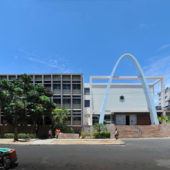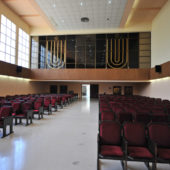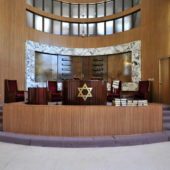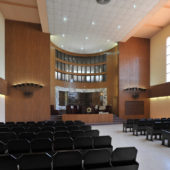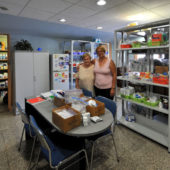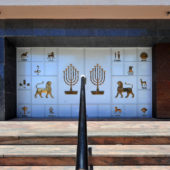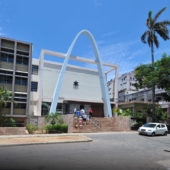First opened in 1953, known as The Patronato, this synagogue has a free pharmacy serving Jews and non-Jews alike.
Jews arrived in Cuba shortly after the expulsion of Jews from Spain in 1492. Popular lore states that three Jews came with Columbus: Luis de Torres on the Santa Maria, Juan de Cabrera on La Pinta and Rodrigo de Triana on La Nina. All three were Marranos, forced Jewish converts to Catholicism. In spite of their practicing the Catholic faith, the hand of the inquisition still reached for them. The first trial of the Inquisition in Havana was against a Jew, Francisco Gomez de Leon, executed in Cartagena, after, of course, confiscating his large fortune, which without doubt was the cause of his persecution.
During the 16th and 17th centuries, many Jews immigrated to Cuba from Brazil, having been persecuted under the Portuguese. The new Jewish immigrants founded trade in Cuba and by the 18th century, Cuban Jewish trade routes included Amsterdam and Hamburg. However, Jews were harassed and many Jews assimilated into Cuban society. At the end of the 1800s, Jews from the Dutch Antilles settled in Cuba. They supported Jose Marti, who freed Cuba from Spanish colonial rule in 1898. After the Spanish-American War, many American Jewish war veterans moved to Cuba and founded a congregation in Havana in 1904. Cuban Jews were involved in all aspects of society and trade. Jews were instrumental in the sugar cane business; they transported sugar cane from Madeira to Brazil and then on to the Antilles. Jews were the first people to use protective cloth to protect tobacco plants from the extremes of weather. This is still being done today to produce the finest quality of tobacco in the world. Many Jewish traders pursuing business in the New World set up outposts on Cuba.
After the Spanish-American War, the Jewish presence became permanent. American Ashkenazi Jews (born in Europe) immigrated to Cuba to work for U.S.-owned plantations and businesses. In 1906, eleven founded the United Hebrew Congregation, a Reform synagogue, that conducted its services in English. This was officially considered to be the beginning of the Jewish community in Cuba. A large number of Jews immigrated to Cuba in 1910 and 1920, including Sephardic Jews from Turkey, as a stop-over point on their way to the United States. However, there was a quota for immigrants allowed into the United States, so many stayed in Cuba, due to the fact that there wasn’t much anti-Semitism. Many of these new immigrants prospered in Cuban’s garment trade. By 1924, 24,000 Jews lived in Cuba. In the 1930s, a central Jewish committee was established as a base for all of the Jewish groups.
At the time of the Castro lead Socialist Revolution in 1959, there were approximately15,000 Jews in Cuba. About 75% of the Jewish population lives in Havana. Jewish people tend to be merchants and entrepreneurial, therefore socialism was not attractive to them and approximately 94% of Cuba’s Jewish population fled after the Revolution. There are less than 2,000 Jews remaining in Cuba, most living in Havana. Jews and Christians were persecuted after the Revolution and had restricted access to jobs and universities. However, they were still allowed to practice their religion, distribute kosher food and to receive donations from other nations. In 1973, Cuba severed diplomatic relations with Israel and is considered to be one of Israel’s worst enemies. In the late 1960s a number of Jews were sent to forced labor camps, having been accused as political dissenters, religious peoples, gays and/or exit applicants. Jewish activists were constantly under surveillance. Predictably, Jewish life went more “underground,” but has still survived. In the 1970s , a synagogue and school in Havana were both closed. In the 1980s, a further synagogue was closed. Throughout the 1980s, even Havana’s largest synagogue, the Patronato, had difficulty forming a minyan (a quorum of ten men required for a religious service). Cuban Jewry faced assimilation and its elders were concerned about the community’s future.
In 1991 a law was passed permitting members of the Communist party to have religious affiliations. This was a significant step in rejuvenating Judaism in Cuba. Due to Cuba’s economic problems, its Jewish community is among the poorest in the world. The JDC (American Joint Distribution Committee has worked to help build up Cuban Jewry and to aid the people on a social level. As of 2011, there are three synagogues in Havana, which survived the Revolution, to serve the 1,000 Jews in the city today: El Patronata (Beth Shalom), Centro Sefardi, and Adath Israel de Cuba. El Patronato is a Conservative synagogue, Centro Sefardi practices the Sephardic rite and Adath Israel is Orthodox.
El Patronato (Beth Shalom) Synagogue and its Jewish Community Center are located in an area of town that used to be home to wealthy Jewish merchants. The Jewish Community Center is the largest in Cuba. The complex is located on a quiet residential street amongst Cuba’s 50s-era U.S. cars and homes that have long lost their grandeur. However, this is a far better location than the average, poverty-stricken Cuban neighborhood. The Center is home to the local federation, a pharmacy dispensing scarce medical supplies free of charge to Jews, Gentiles and even the Havana general hospital. These supplies are mostly provided Jewish visitors from other countries. If fact, the Synagogues360 photographer and his wife brought 50 lbs of badly needed medical supplies to the pharmacy.
There is also a small library with full-time librarian (who is also the temple’s lay-leader), a conference room, youth center and multipurpose room. The youth center is well-stocked with three on-line computers (in a country where computers and internet availability are difficult to come by), plasma TV, a Wii gaming system, exercise equipment and a pool table, and it works – the youth love congregating here. These are not amenities easily found in Cuba. The congregants are trying to create a real community center and to attract as many Jews as possible. Many of the worshippers on Friday nights are young people in t-shirts and sandals. They fill the front rows of the prayer room, enjoy the upbeat tunes and occasionally spontaneously dance. Approximately 160 students attend the weekly religious school, and they enjoy spending their free time at the community center. Shabbat dinner is provided after the service every Friday, to ensure the congregants receive at least one good meal each week. A typical meal would be mashed potatoes, shredded cabbage and chicken. Cuban dancing, followed by Hebrew dancing, would complete the evening. Every Sunday morning, there is a bus that picks up children and adults for Sunday school and breakfast.
El Patronato synagogue was built in 1953, before the Castro led revolution. It is a modern, 50s cement structure with a large powder blue arch that soars above the height of the building, across the front of the building’s facade. The portico at the front of the building is of black and red marble, with a large white piece of artwork inset into the wall, featuring Jewish symbols gilded in relief. The steps up to the entrance are also of marble. Inside the purpose-built prayer room, ivory walls are offset by wide strips of wood, which house soft down-lighting. The same wood frames the bimah and the entire concave front wall and Aron Kodesh. The Aron Kodesh is rectangular in shape, framed in white marble. Four simple, plain wood doors with five horizontal pieces of wood on the two center doors, house the Torah scrolls. The tivah (reader’s desk) is situated directly in front of the Aron Kodesh, and is constructed of vertical wood slats. A gold Star-of-David adorns the front of the tivah. A wood gate, also constructed of vertical slats using a lighter colored wood lines the front of the bimah. Large, paned windows adorn the right side of the prayer room, and there are three rows of thirteen windows in the concave wall above the Aron Kodesh. Upstairs, at the back of the sanctuary, there is a wall of windows with gold geometric shapes of menorahs and Stars-of-David; this acts as a screen for the women’s gallery. Beautifully carved, purpose-built, simple wood chairs fill the prayer room.
Guests to the El Patronato have included Steven Spielberg, Sean Penn and Fidel Castro. President Raul Castro lit the first Hanukkah candle of 2010 in this synagogue.

